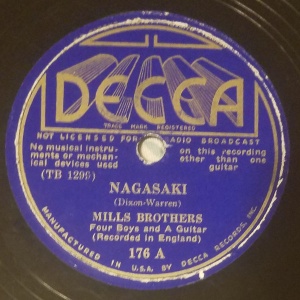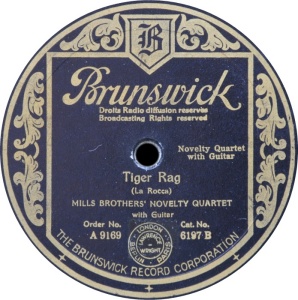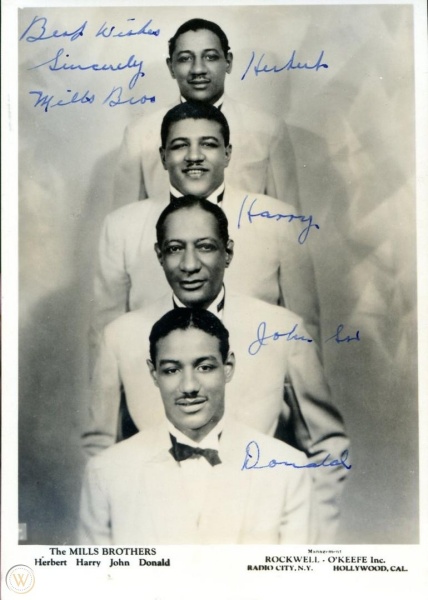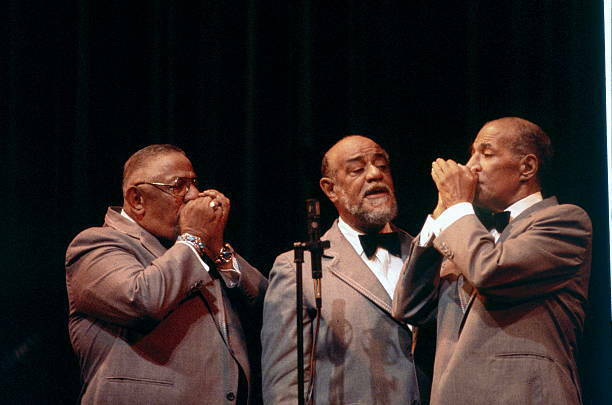Nagasaki: Four Guys Named Mills Sing Some (Not Very) Japanese Jazz
After bringing three daughters into their young family, John and Eathel Mills of Piqua, Ohio added four boys to their brood between 1910 and 1915. John Jr., Herbert, Harry and Donald Mills would begin one of the most durable and most loved vocal groups of the twentieth century, blazing a trail for many sibling groups who would come later. One of the earliest of such groups, the Mills Brothers are not typically thought of as jazz singers. But for the first decade or so of their careers, they most certainly were, and they put out a series of performances that still makes for great listening today.
As kids, the boys would sing for pocket change outside of their father’s barbershop and, by 1924, got up the nerve to sing for real money – four dollars – during movie intermissions. They ranged in age from 9 to 14, and Harry played a kazoo in addition to singing. One night he forgot the kazoo and improvised – buzzing through his cupped hands, he was amazed to hear the sound of a trumpet.
Four years later a local band went to audition for Cincinnati’s powerful WLW radio station and took the brothers along to sing with the band. WLW was not impressed and sent them all packing back to Piqua. They tried a couple of years later and the band was sent home once again. But the four brothers (known by 1930 as Four Boys and a Guitar) were hired. Within the year they had made contact with some people of influence and headed to New York City for an audition with CBS Radio.
The story is that someone told CBS President William S. Paley to turn on his speaker and listen to the audition. If the story is true it was a good move because Paley ordered them hired at $140 a week. In short order the group (now known as The Mills Brothers) found themselves as the first African-American performers with their own network radio show, and making $3,250 a week to go along with it – when you could get a nice new Ford for under $650.
The four boys had a unique vocal blend that could probably only come from brothers. Donald, the youngest, sang lead tenor. Herbert was second tenor with Harry singing baratone and John Jr. singing bass. Just as notable as their vocal blend was their ability to mimic instruments – trumpets, trombones and a bass were part of their performance. They were so convincing that early radio announcers and record labels proclaimed that no musical instruments besides a guitar were used in their performances.
They were soon playing the Palace theater (the ultimate venue of the day, and the place to signify that a performer had really “made it”), had a million selling record (1931’s Tiger Rag) and were in the movies (1932’s The Big Broadcast). These guys were absolutely killing it, to the point that in 1934 they were the first African-American performers to give a command performance for the British Throne. By the time the swing era was well established in the mid 1930’s, the Mills Brothers were already in the top tier of the music business and would stay there for many years to come.
This particular disc was recorded June 13th of 1934 in Decca Records’ London studios during that trip. Nagasaki was a typical tune from the 1920’s which matched a catchy melody with clever (if culturally insensitive) lyrics and hitched itself to a public fascination with exotic locales. The early recordings by other bands were at a much more sedate tempo, while later versions picked up the pace and this one fits in that style.
Harry’s “trumpet” is featured prominently, as is John Jr.’s bass. The boys also made use of some Cab Calloway-style scatting. But they really shone in the vocals that were always together, even when the words come fast and furious (“back in Nagasaki where the men all chew tobakky and the women wickey wackey woo.) Even with the up-tempo goofy lyrics, these guys brought a vocal blend that was as smooth going down as a hot toddy on a cold winter’s evening. The song, of course, never became a standard and has largely fallen into a memory hole. I think it may have had at least something to do with an atomic bomb.
If you prefer your music with some visuals, there are plenty of old film appearances to choose from. Cab Calloway was in a lot of films because he was such a dynamic and visual performer. The Mills Brothers got in the movies because they were so doggone popular. In fact, their early trajectory was much like Calloway, with hit records, movies and even prominent roles in a couple of Fleisher cartoons, all between 1931 and 33. The piece above (The Old Man Of The Mountain) is from a musical short film The Little Broadcast of 1933.
OK, I couldn’t make up my mind for which film clip to use – the Old Man Of The Mountain or this one, “I Heard” from the 1934 musical comedy called Twenty Million Sweethearts. Oh heck, we’ll just use both. That is the problem with this group, almost everything they did in their first five years (and beyond) is an unbeatable combination of toe-tapping fun and their impeccable sense of phrasing and swing. And John Jr’s work on the guitar should not be overlooked as it adds just the right touch, neither too much nor too little.
Tragedy struck the group when John Jr. became ill during a second European tour in 1935, which led to his death in early 1936 of either pneumonia or tuberculosis, depending on the source. But in one of the more unusual responses to the death of a key member of the group, their bass-voiced father John Sr. stepped in to Jr.’s role and the group continued an almost unbroken string of successes for the next twenty years. It was during this time that the Brothers saw how vocal music had eclipsed instrumentals in popularity and they were perfectly positioned to move beyond their faux instrumentals to rule the pop charts as singers. Which they did with the 1943 release of Paper Doll – which has the distinction of being THE most popular record of the entire decade of the 1940’s, remaining on the charts for a full thirty weeks. Fun fact – Paper Doll was a B side that the boys riffed off in about fifteen minutes. A DJ somewhere played the flip side of the popular I’ll Be Around and that was that. Their final million-seller was 1952’s Glow Worm.
John Sr. finally retired from this second career in 1956 at the age of 74, at which point the Brothers became a trio that was still charting hits as late as 1970. The brothers continued performing regularly until time took them out one by one, with Harry dying in 1982 after being virtually blind from diabetes for a decade. Herbert died in 1989, and finally kid-brother Donald (who performed with his son John II at the end) in 1999. Let that sink in – Donald Mills was singing professionally (and drawing audiences) for over seventy years. Older readers may recall an American Express Card commercial from 1979 that was near the end of their time as a trio.
The Mills Brothers are surely not the first name that comes to mind when the topic of jazz singers comes up. Their music mellowed with the age of their core audience, which is likely why they are usually thought of in the same easy listening category as Nat King Cole the 1950’s balladeer. But for those willing to dig a little, the Mills Brothers cut some mighty good jazz records in the 1930’s with performances that were both highly popular and genuinely good. Which has always been a tough combination that few can achieve. Doing so as a genuine class-act from beginning to end is even tougher.
Music Credits:
Nagasaki – Decca Records, 1934 – From the YouTube Mills Brothers – Topic page
The Old Man On The Mountain, 1933 – Film clip from the YouTube page of iTubeNL
Photo Credits:
Opening Photo – publicity photo c. 1932 from the cover art of a CD pictured on Discogs.com
c. 1930 publicity photo without copyright markings found via the website of Pennsylvania Heritage
1934 Decca Records label for Nagasaki, from discogs.com
1931 Brunswick Records label for Tiger Rag from 45world.com
Publicity photo from c. 1938 without copyright markings as offered for sale at worthpoint.com
c. 1981 photo offered for sale on eBay







Tremendous! I grew up listening to the Mills Brothers. Mom had a collection and some of it was the older stuff.
LikeLiked by 1 person
They didn’t really make my parents’ radar, for whatever reason. The first time I remember hearing them and understanding who they were was on a television appearance in the early 70s – possibly the Jerry Lewis Telethon or one of the variety shows that was still on. I liked them but never dove in deeply. It was a worthwhile dive!
LikeLike
Yeah I grew up listening to them as well. My Dad would play them on a Sunday afternoon. I grew to enjoy their music, and now occasionally play Cab Driver or Glow Worm in the car. I wish I had kept the vinyl albums. Thanks for this JP, this is a great history lesson I never had the pleasure of enjoying.
LikeLiked by 1 person
I think the only thing I have of them on record was a late 1960s album they did with the Count Basie band. The funny thing is that I slid into this vein quite by accident. I came across another version of Nagasaki that was a hot jazz record put out by a group that never did anything else of the kind. As I usually do, I looked at some other versions for context and this one came up. It made for a much better subject!
LikeLike
Thank you J.P. – such an interesting read and listen. I wasn’t old enough to remember the Mills Brothers music but I do remember the name. I can’t get over the “instruments”, especially the trumpet and John Jr. on “bass” and guitar at the same time. The scat in “I Heard” is awesome. Given the turmoil in the world right now I think many of us would love to step back in time and pay the Brothers a visit.
LikeLiked by 1 person
I know exactly what you mean. I feel a little kinship with them given the Piqua Ohio thing, a place only 2 or 3 counties away from where a lot of my family is from.
LikeLike
Hmm, most popular record of the 1940s and I’d never heard of them. Thanks for another learning point.
LikeLiked by 1 person
It is funny that as long as they were around and as popular as they were for most of that time, they kept a very low profile in real life. So many famous people have stories told about their unique personality traits, but these guys were the kind of low-key people I have come to expect from those who come from northwestern Ohio towns of 15-20k people.
I looked and 50 million records sold is not enough to get someone into the top tiers any more, but it isn’t bad for someone whose peak record sales came before the 1960s. By contrast, Aretha Franklin sold 75 million in an age when so many more people bought records.
LikeLike
I had heard of them but thought of them as a more 50’s act and was surprised by what I remembered – Paper Doll, Glow Worm and surprisingly that Tiger song….maybe it was used in a commercial once?
LikeLiked by 1 person
Good question on the Tiger Rag. That was first done by the first band that had commercial success at jazz about 1917-18, and has been a kind of perennial, being kept alive today mainly by Dixieland-style groups. It has probably been used in advertising through the decades.
LikeLiked by 1 person
I checked Wikipedia….probably a football game recording…..or maybe Tony the Tiger selling Kelloggs or the Esso gas campaign to Put A Tiger in Your Tank – at any rate some childhood memory stuck in my brain. Nice to know the origins of it anyway.
LikeLiked by 1 person
Tiger Rag, and Muskrat Ramble have been amazingly co-opted in advertising and pop culture for about as long as they existed! I remember when I finally figured out Country Joe and the Fish’s Vietnam Song was Muskrat Ramble!
LikeLiked by 1 person
My Dad was a big Mills Brothers and Ink Spots fan, so I’m pretty “hep”. But he was a “voice” guy, and even tho he was born and raised in Chicago, he ended up at Purdue after the war on the GI bill, and in their world famous Glee Club, with his brother as well; back in the 40’s! Another thing to know is that the Japanese LOVE jazz, and have been producing a steady steam of virgin vinyl and high-rez CD’s from jazz reissues since at least the 70’s! Always look for the Japanese jazz import CD’s if you can get them; they’re the toppest of quality!
LikeLiked by 1 person
That’s cool about your Dad. I have heard that the Japanese have been the place to be for high quality vinyl records in modern times.
LikeLike
Pingback: The Boswell Sisters (or How Three Little Girls From New Orleans Changed Popular Jazz Singing) | J. P.'s Blog